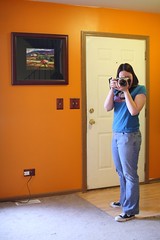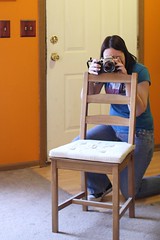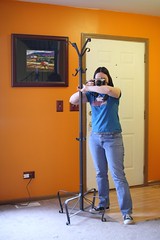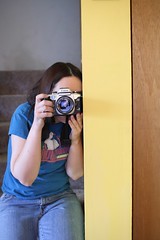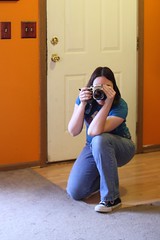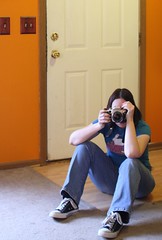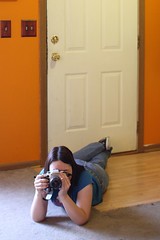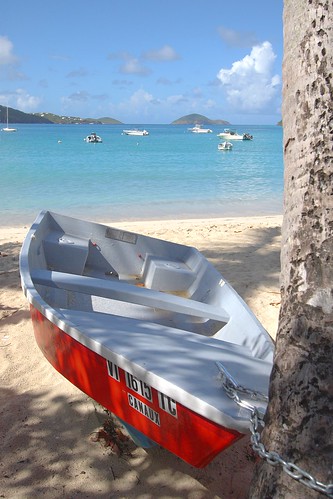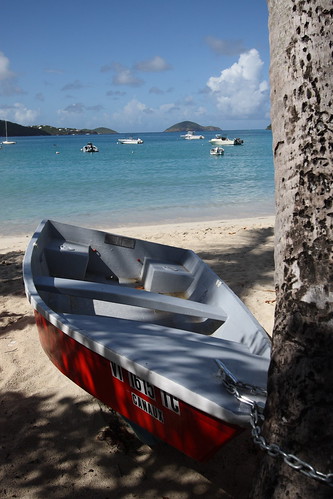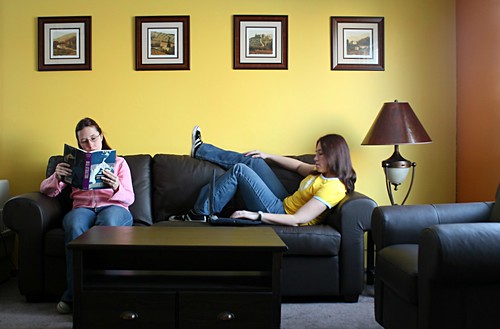
The above image illustrates an effect known as "Light Painting". It's an effect you can achieve with your camera alone -no special software knowledge is necessary!
"Light painting" is a fun way to let your creativity flow. Kids love playing with it, but I've found that it's equally as entertaining to adults, turning them into kids after the first time they see the effect for themselves. But besides being fun, it's a great exercise on just how light interacts with your film or sensor to create an image, so here's how it's done...
What you need:
- A tripod
- A light source such as a flashlight, sparkler, etc. "Erica" in the above image was written with a $2 one-LED flashlight
- A camera, with a flash (on-camera flash is fine), that will allow you to select a long shutter speed.
Setup:
You need the environment to be almost, if not totally, dark for this to work. Set up your tripod with your camera mounted on it, and set the camera on Manual Mode ("M" on Canon cameras), then set a shutter speed of 10 seconds (on Canons you want it to look like 5" or 10" -the quote mark indicates FULL seconds rather than fractions of seconds like 1/5sec or 1/10sec which are displayed as just 5 or 10).
This long shutter speed is required to give you enough time for the camera to take a still shot of you (while the flash fires) and then for you to draw or write whatever you want with the flashlight or other light source after that. If you find 10 seconds too long or too short you can change it later.
Set the aperture to f/11 -this will give you a fairly deep depth of field in case your focus is off (which is easy to do in the dark).
Set your ISO to 400.
Now have your subject take his/her place (you may want to mark the spot so you don't have to keep re-focusing), and then have them put their flashlight on their face so you can focus on them. -If you're doing a self portrait, get a stand in (a broom?) or just guess and take some practice shots 'til you get it right.
When you're all set up, make sure your subject has the flashlight (or other light source) ready and have them stand in front of the camera in whatever (still) pose you'd like them to appear in. Then, press the shutter. (If this is a self portrait, turn the camera timer on, press the shutter and run into your position, pose and wait for it to take your picture.)
At this point, the flash will fire and light up the subject in his/her pose. As soon as the flash is done the subject can begin to draw or write with the flashlight (or whatever) until the shutter closes (you'll be able to hear it close) or until they are finished. If they are finished before the shutter closes, they should run out of the area that the camera is focused on so that neither they nor the light source will continue to be recorded on the film or sensor. (If they run, they'll need to turn off or cover the light source while they move so that it does not continue to be recorded as they run!)
**NOTE:** If your subject is going to write something, they'll have to write it backwards since they are facing the camera. -You may want to have them practice it beforehand!
After the shutter closes, review the image on your LCD to make sure it isn't over or under-exposed. If you can see blurring ghostly images of the subject while he/she was writing or drawing, then you'll need to lower the ISO to 100 or 200 and/or find a darker environment to take the photos in. If the picture is too dark, try increasing the ISO to 800. -If you are shooting film, just make sure it's as dark as possible.
Why it works:
Cameras simply record light. Bright lights take much less time to be recorded than faint light does. So, when the flash fires it records the image of the subject onto the film or sensor very quickly because the flash lights them up so much more than when it goes off. And after the flash is complete, the shutter remains open, but since it's so dark, images will take a looong time to record. So, while the subject moves, you won't be able to see them or their movements on the photo when it's complete. All you'll see is the movement of the flashlight (or whatever), since light is all that a camera records.
When you dial in the settings you may notice that the camera's light meter says the photo's exposure will be way off, but you can ignore it. The camera's light meter has no idea that we don't care about the fact that the background won't be recorded and it also doesn't know that the flashlight's going to appear and that that's really what we want to see, etc. The settings I've chosen just rely on the fact that bright light is recorded quickly, so neither of them matter much and there's really no balancing to be done between them like there is during the daytime. This is why the shutter speed of 10 seconds can be changed without having to worry about how it'll effect exposure it won't (at least not by much).
